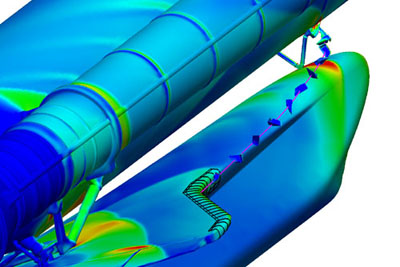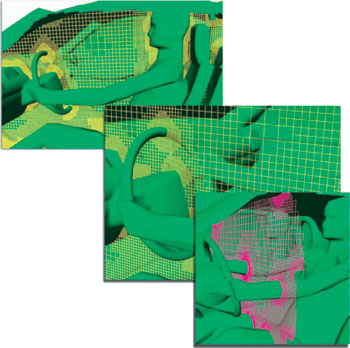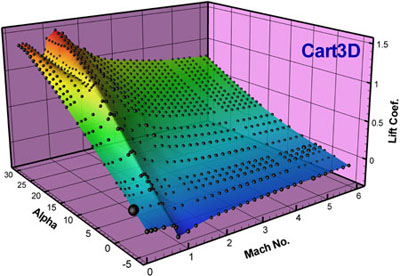Contributed by Michael J. Aftosmis
NASA Advanced Supercomputing Division, NASA Ames Research Center
The Engineers
Michael Aftosmis (NASA) and Scott Murman (ELORET) work at the NASA Advanced Supercomputing (NAS) Division at NASA Ames Research Center. NAS was founded in 1984 to develop, demonstrate, and deliver innovative, distributed heterogeneous computing capabilities to enable NASA projects and missions.

Using Tecplot 360, foam debris trajectory from NASA’s Cart3D simulation package is visualized. A 1.67 pound slab of insulating foam is seen falling off the external tank after Columbia’s launch and hitting the left wing. The Columbia Accident Investigation Board (CAIB) has identified a debris event like this as the most likely cause of the Columbia disaster. This image was used in the CAIB’s final report.
Columbia Accident Investigation Board Results
The plot is a composite image extracted from a three-dimensional computational fluid dynamic simulation performed with Cart3D, a comprehensive computer simulation program. The simulation was performed over the entire Space Transportation System (STS) launch configuration to support CAIB’s investigation into the Columbia accident.
This image above illustrates the computed trajectory for a piece of foam debris emanating from the bipod ramp. Calculations used the aerodynamic and mass properties of bipod ramp foam, coupled with the complex flow field during ascent, to determine the likely position and velocity histories of the foam.
The geometry is colored by surface pressure. The outlines of the reinforced carbon-carbon leading edge panels are overlayed on the leading-edge of the orbiter wing.
Data set was generated using 96 CPUs of NASA Ames’ 1024 CPU SGI Origin 3000 — the largest shared memory system in the world. Approximately 400 such simulations were performed in support of the Columbia crash investigation between February and May of 2003.
Cart3D
Cart3D is an inviscid aerodynamic analysis package including surface modeling, mesh generation and flow simulation. The package performs automated mesh generation and flow solution around solid geometry imported directly from CAD models. The software package, an outgrowth of joint research at both NASA Ames and New York University, is a co-winner of NASA’s “Software of the Year” award in 2002. It has been commercialized by ANSYS/ICEM CFD for private and commercial use in a variety of industries. Download a full description of Cart3D (Cart3D.pdf 327 KB).

Cart3D mesh generation on a automotive interior geometry from ANSYS/ICEM CFD visualized with Tecplot 360. Cart3D’s volume meshing is extremely fast — millions of cells are generated in minutes on desktop machines. This mesh was created in 55 seconds.
Other NAS Projects
Mike is part of a group that developed the AeroDB system, an automated CFD system running large parameter studies (a collection of computer jobs with a slightly different input for each job). AeroDB boils down the testing process of aerospace vehicle design, saving both time and money.
AeroDB Results
The plot below summarizes the results of several hundred Cart3D simulations on the Liquid-Glide-Back-Booster (a conceptual design for a new, reusable launch vehicle). The plot shows the variation of lift with mach number and angle of attack. Each sphere in the plot represents one CFD run and is sized by the number of iterations in the run.

Several hundred CFD simulations summarized in one plot.
Tecplot 360
Automation is the major driver of Cart3D and visualization. “We rely heavily on macros…and script almost everything,” Mike says. “Macros create all of our plots, and Tecplot’s TecIO library is called to plot simulation snapshots.”
For the Columbia image, several snapshots are overlaid to produce the final image. Scripts and macros generated views of the debris simulation from various camera angles along with trajectory animations.
Sources
Columbia Accident Investigation Board Report, August 2003, Report Volume 1, pp. 60-62.
Amundson, Holly A., “Completing Large Parameter Studies with Time to Spare,” Gridpoints, Winter 2003, Vol. 4, No. 1, pp. 4-7.




